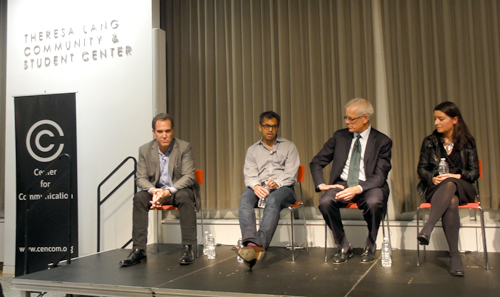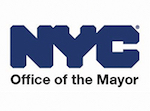 |
| Max Robins, contributor to Techonomy Media; Shafqat Islam, CEO, NewsCred; Martin Nisenholtz, former chief digital officer, New York Times, and Elizabeth Spiers, Flavorpill Productions, former editor-in-chief, The New York Observer. photo: Sharlene Spingler, O'Dwyer's |
“Media Disruption: The New Normal,” was the topic of the evening session at the New School hosted by the Center for Communication, a non-profit that brings together media figures and students in the New York area.
The audience of 253 consisted mostly of students and jobseekers. Some seniors were also present.
They peppered the five panelists with questions about how money can be earned in what have become “battle conditions” in the media arena.
Almost no hard answers were given to them.
One exception was speaker Shafqat Islam, co-founder and CEO of NewsCred, which licenses content from the New York Times, Economist and other media for use in branded marketing programs.
He said his company is noted for paying writers and contributors well. Articles are often purchased at prices from $500 to $1,000. Islam invited interested writers to contact him since he is building up a network of contributors.
Islam cited Red Bull Media House as “an interesting pocket of quality” that is doing well.
The company focuses on sports, culture and lifestyle.
Nisenholtz Sees New Era of Reporting
Martin Nisenholtz, former chief digital officer of the NYT who retired in 2011, said media have thrown off the shackles of unions and the costs of paper, printing and distribution, and can now focus on reporting.
He said the search for talented journalists is on again.
Some students wondered if media had thrown off the “shackles” of income since online news portions of publications have not come close to replacing ad revenues that had been generated by their print operations. U.S. newspaper ad revenues have dropped from $49 billion in 2006 to $23 billion last year.
Nisenholtz led the acquisition of About.com from Primedia in 2005.
NYT paid $410 million for the website and sold it in 2012 for $300 million to Barry Diller of IAC.
Elizabeth Spiers, former editor-in-chief of The New York Observer who is now acting editorial director of Flavorpill Productions, which covers cultural topics, said media have been “re-democratized” and wrestled out of the hands of the bigwigs of previous generations. The result will be more emphasis on “merit,” she said.
Max Robins, contributor to Techonomy Media, said his articles for Forbes are paid based on how much traffic they draw. He sees his goal as covering subjects that will bring the maximum amount of visitors.
Some in the audience said that that Robbins appears to be compromising his journalistic principles. Nisenholtz said Robbins’ concern with traffic could be “corrosive.”
Ben Smith, who joined BuzzFeed www.buzzfeed.com in 2012 after being a senior political writer for Politico from 2007 to 2008, said journalism is best learned on the job rather than in classrooms.
However, recent grads and other journalists who can’t find jobs are enrolling in degree and certificate-granting programs in a bid to catch the attention of media.
City University of New York held an open house last night for those interested in its new graduate courses in Entrepreneurial Journalism. Attendance was 15. CUNY offers a certificate in the subject at a cost of $4,910 for a program that lasts one semester. An M.A. in the program is also available.
The Tow-Knight Entrepreneurial Center at the school will host a “demo night for startups” Tuesday Oct. 22 starting at 6:30 p.m. Cost is $5 per person. The school is at 219 W. 40th st.
Cencom Programs Open to Public
The Center for Communications (EIN: 13-3060074) has programs open to the general public as well as seminars for students only.
A 1994 session featured a number of media and PR figures and had “Ethics in PR” as its topic.
Among the speakers was Epping, N.H., counselor Patrick Jackson, who was president of PR Society of America in 1980.
Jackson told Morley Safer of “60 Minutes” that his policy with the press was to “duck ‘em,” “screw ‘em,” and “go direct.”
Safer replied that happened to be his attitude towards PR people.
Manning, Selvage and Lee had set up a perpetual $5,000 yearly fund to finance an annual PRSA ethics conference. But there was such negative fallout from the first one that there never was a second one.
The session was videotaped and a copy was made available to the press.
The Oct. 8 program was also videotaped and portions will be available in about a week via the YouTube section of the CenCom site. A DVD of the event will be sold in about a month.
CenCom had contributions and grants totaling $511,775 in 2011, its latest year available on GuideStar. Net assets as of Dec. 31, 2011, were $510,000.
It has a banquet each year honoring a media figure. The 2013 honoree was Matthew Blank, CEO of Showtime Networks.
Many Schools Represented
Colleges and universities represented by students in the audience included Long Island University, Queens College, CUNY Graduate School of Journalism, Center for Puerto Rican Studies at CUNY, NYU Steinhardt School, Parsons, NYIT, The New School, Baruch College, St Johns University, Wagner College, Columbia University, Bronx Leadership Academy, Hunter College, Brooklyn College, NYU Media Culture and Communications, Fashion Institute of Technology, Fordham University, LIM College, School of Visual Arts, Hofstra University.


 MedGlobal, a Rolling Meadows (IL) nonprofit that provides medical and health education services to refugees and displaced persons in disaster-affected and underserved countries, is looking for a marketing and communication director.
MedGlobal, a Rolling Meadows (IL) nonprofit that provides medical and health education services to refugees and displaced persons in disaster-affected and underserved countries, is looking for a marketing and communication director. The College of William & Mary, which was chartered in 1693, is looking for a director of PR strategy to head its newly formed content & strategy team.
The College of William & Mary, which was chartered in 1693, is looking for a director of PR strategy to head its newly formed content & strategy team. New York City’s The Mayor’s Office for International Affairs is seeking a director of communications and speechwriting.
New York City’s The Mayor’s Office for International Affairs is seeking a director of communications and speechwriting. PR Society of America’s New York chapter, noting it is the “leading communications society in the largest media market,” has launched a Career Center serving job seekers and recruiters.
PR Society of America’s New York chapter, noting it is the “leading communications society in the largest media market,” has launched a Career Center serving job seekers and recruiters.


 Have a comment? Send it to
Have a comment? Send it to 
No comments have been submitted for this story yet.